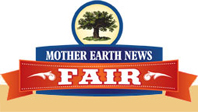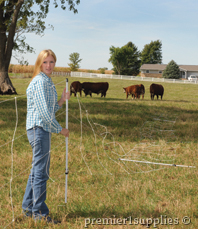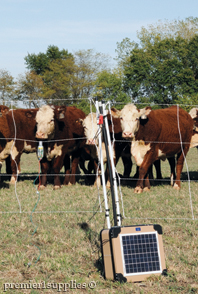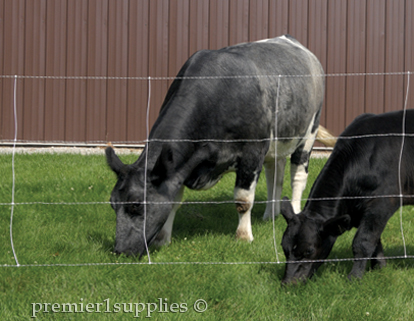MOTHER EARTH NEWS FAIR
 Visit us at
Visit us at
Mother Earth News Fair
Premier's booth #6604 & 6605
Asheville, NC
April 12-13, 2014
Premier's booth #1221 & 1320
Puyallup, WA
May 31-June 1, 2014
Premier's booth #151 & 153
Seven Springs, PA
September 12-14, 2014
Premier's booth -- TBA
Topeka, KS
October 25-26, 2014
CATTLE QUIKFENCE

Cattle QuikFence is a useful way to subdivide cattle pastures into smaller grazing paddocks.
Cattle QuikFence™ 4/48/24
Our most reliable semi-permanent electrified cattle fence. Has very visible (extra large) strands. Consists of 4 “hot” interconnected “wires.” Bottom strand suspended 1 ft above the soil. 48" tall. PVC line posts (3/4" dia) are built into each roll and have a step-in foot. Easy, simple and fast to install—and equally simple to remove. Be sure to use an energizer to properly electrify the netting.
Easy-To-Install Instructions
QuikFence ships as a roll with all line posts already built in. To install, just unfold it and set the posts (by hand) with only hand tension. Add support post at corners and curves. It adjusts to terrain and curves better than any other fence. We support it at corners with FiberTuff™ posts or steel T posts.
Uses
| • |
Cows with calves. Curious calves learn to avoid QuikFence because it’s so visible and has multiple “hot” wires near their noses. |
| • |
Protecting windbreaks and feed supplies. Ease of setup lets you quickly make a secure enclosure. |
Is QuikFence expensive?
It’s more $$/1000 ft than reel-based cattle fences. But no other fence design comes close if you need temporary or semi-permanent fence that’s simple, fast to install, visible and very effective.
See more Cattle Fence Options
PREMIER SOLAR ENERGIZERS

Cattle QuikFence with a PRS energizer.
PRS Solar Energizers
Key Features…
| • |
High output |
| • |
Half the cost per joule |
| • |
Strong metal case |
| • |
Less vandal and theft risk |
| • |
Very portable |
| • |
Can sit on the ground |
| • |
Can store fence tester inside |
Benefits…
| • |
Lowest price/joule for solar units. |
| • |
Can be set on the soil. In summer a near-flat angle facing south works. In fall, winter and spring increase the angle. The goal is to keep the panel perpendicular to the sun’s noontime rays. In winter raise the unit above the snow. |
| • |
Less likely target for vandals and thieves due to brown color plus placement on or near the soil. |
| • |
All-metal custom-made case of aluminum and stainless steel that’s strong and rugged. |
| • |
Light brown color to reduce internal heat buildup. |
| • |
Very simple to install and use. |
View our Comparison Chart
|
 |
 |

Need to graze some under-utilized portions of your farm? Use Cattle QuikFence™ to set up short-term paddocks almost anywhere.
Simple Fence Solution—
Cattle QuikFence™
We had our first warm rain of the season last week, which means the pastures are rapidly changing from dull browns to bright vibrant greens. As the pastures green up, they also fill up with newborn calves and their mothers. To help with the influx of calves and management needs, in this newsletter we've included articles focusing on calving season management and raising from newborn to 3 months of age.
CALVING
Calving Time Management for Beef Cows and Heifers
By Animal Science Department, Oklahoma Cooperative Extension Service, Oklahoma State University
Calf losses at calving time are often a result of dystocia (difficult calving) problems. Many of these losses occur to calves born to first calf heifers and can be prevented if the heifers and cows are watched closely and the dystocia problems detected and corrected early. A veterinarian should handle serious and complicated calving problems. Ranchers must use good judgment in their decisions as to which problems will require professional help, and the earlier help is sought the greater the survival rate of both cow and calf.
Recognize Normal Calving
If the calf is normally presented (Figure 1, see under the "Read More") and the pelvic area is large enough, the vast majority of animals will give birth without assistance. Recognizing a normal calving is just as important as knowing when a calving is abnormal. This way you will not give help when it is not needed.
The Three Stages of Parturition
Stage 1
The first stage of parturition is dilation of the cervix. The normal cervix is tightly closed right up until the cervical plug is completely dissolved. In stage 1, cervical dilation begins some four to 24 hours before the actual birth. During this time the progesterone block is no longer present and the uterine muscles are becoming more sensitive to all factors that increase the rate and strength of contractions. At the beginning, the contractile forces primarily influence the relaxation of the cervix but uterine muscular activity is still rather quiet. Stage 1 is likely to go completely unnoticed, but there may be some behavioral differences such as isolation or discomfort. Near the end of stage 1 ranchers may observe elevation of the tail, switching of the tail, and increased mucous discharge.
Stage 2
The second stage of parturition is defined as the delivery of the newborn. It begins with the entrance of the membranes and fetus into the pelvic canal and ends with the completed birth of the calf. The second stage is the one producers are really interested in because this is where all the action is. Clinically the onset of stage 2 is marked by the appearance of membranes or water bag at the vulva. The traditional texts, fact sheets, magazines, and other publications state that stage 2 in cattle lasts from two to four hours. Data from Oklahoma State University and the USDA experiment station at Miles City, Montana, would indicate that stage 2 is much shorter being approximately one hour for heifers and one-half hour for adult cows. See When and How to Examine a Cow on page 3. In heifers, not only is the pelvic opening smaller, but also the soft tissue has never been expanded. Older cows have had deliveries before and birth should go quite rapidly unless there is some abnormality such as a very large calf, backwards calf, leg back, or twins.
Read More »
CALVES—THE FIRST FEW MONTHS
Feeding and Managing Baby Calves from Birth to 3 Months of Age
By Donna M. Amaral-Phillips, Patty B. Scharko, John T. Johns, and Sharon Franklin, University of Kentucky, College of Agriculture
As the future productive units of a dairy herd, heifers represent a substantial financial investment in feed and labor. This investment needs to be protected by managing and feeding these heifers so that they grow economically and at an optimal rate in order to calve at 24 months of age. The first two to three months of life is a critical period to achieving these objectives. This factsheet explains the critical steps in raising calves during this time period. These steps are important for raising not only dairy heifers but also orphan beef calves.
Dry Cow Nutrition Program
Sound feeding and management programs for young calves start with the dam or mother two months prior to calving. The majority of the growth of the calf within the dam occurs within the last two months of gestation, and the dam provides the nutrients needed for this growth. Also, the management program of the dam affects the quality and amount of antibodies found in her colostrum, or first milk, which directly impacts the health of the calf after birth.
Dry cows should be fed a diet that is balanced to meet their nutrient needs and support the growth of the fetus. If a heifer or cow is slightly underfed energy and/or protein, the fetus will still grow to the same size as if she was fed properly, but she will sacrifice her own body reserves or growth to support the growth of the fetus inside her. Basically, the growth of the fetus has a higher nutrient priority than the growth of the bred heifer or the ability of a mature cow to maintain her body fat stores. Underfed heifers will have more trouble calving. Older cows will use their body stores of fat and protein, and these stores will not be available to support milk production after calving. The important message is that underfeeding dry cows and springing heifers does not result in a smaller calf but instead results in lower performance of the cow or heifer after calving.
Adequate minerals and vitamins are important to the dry cow and the calf developing inside her. They are also necessary for the dam to minimize health problems around freshening time, such as preventing retained placentas, and to improve the immune system so that the cow can fight off a disease challenge, such as mastitis infection, just before or after calving. The recommended concentration of selected minerals and vitamins in the total diet is shown in Table 1 (see under "READ MORE" below). In addition, deficiencies of minerals, such as phosphorus, manganese, cobalt, copper, zinc, and selenium, can result in deficiencies in the fetus as well as the newborn calf. Thus, adequate (not excessive) amounts of each mineral and vitamin need to be consumed for the health and wellbeing of both the dam and the unborn calf.
Read More »
|
|